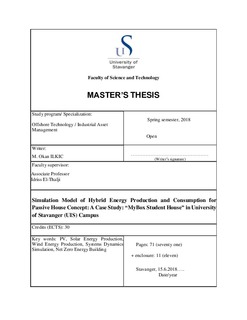| dc.contributor.advisor | El-Thalji, Idriss | |
| dc.contributor.author | Ilkic, Mustafa Okan | |
| dc.date.accessioned | 2018-09-12T12:56:05Z | |
| dc.date.available | 2018-09-12T12:56:05Z | |
| dc.date.issued | 2018-06-14 | |
| dc.identifier.uri | http://hdl.handle.net/11250/2562249 | |
| dc.description | Master's thesis in Offshore technology : Industrial asset management | nb_NO |
| dc.description.abstract | It was believed in that the level of the consumed energy was a proof for each country to show the technical, economic and social development indicator for many years in the past. Unfortunately this approach could be applicable as the “limited” resources such as Oil, Coal, Gas etc. exist on the planet on earth or at least inside the country’s borders. The main objectives related to the energy policy of the counties were increasing the produced energy, using own resources to produce energy and creating new alternative energy resources to achieve first two targets. As a result of that the countries paid attention to increase the number of facilities which uses these resources and pollute the environment beyond the control and unpredictable ways. Also this intellection were caused countries to use nuclear energy which
was developed as a weapon at the Second World War. Unfortunately, the pollution gas and other chemicals to the environment showed their results earlier than expected and introduced us with a new term of “Global Warming” at the end of 90s. Nuclear accidents and other industrial chemical accidents which effect the huge number of inhabitants and environments for many years, helped us to understand about their risks and the “Black Swans” they still have.
Green energy concept was invented during that time as the precision about environment was increased first in public then among the governments. The researches about the wind, solar, wave, deep water streams were seen as a solution for the increased energy consumption, polluted environment and changed climates. The researches for this alternative resources started many years especially for space industry but elapsed time proved that the especially wind and solar can be critical and implacable for countries for their energy policy.
It was also understood that to diversify the energy resources and increase the efficiency of the green energy resources might not be useful without proper energy efficiency policy and energy saving policy. Using wind turbines, PV Panels and other mentioned alternative green energy resources can be effective and useful to make “Off-Grid” houses which produces its own energy and disconnect to the grid line, only when this two policies are fallowed strictly by users and governments.
There are many names to describe a house which produces its needed energy for all year by using the wind, PV panels, rain, waves and others with some differences. They can be listed as “Passive House”, “Green House”, “Zero Energy Building”, “and Low Energy Building” and “Off-Grid House”. With current technology, it is much easier to design a “Passive House” by following the energy saving and energy efficiency politics, using the simulation and 3D drawing software. It is possible to simulate the design a building to maximize the energy production and minimize the energy consumption by considering the climate and environment of the related country and energy consumption behaviors of inhabitants.
This thesis can be considered to be the first step of converting an existing house (A student house called Mybox) at university of Stavanger (Norway) to explore how it is possible and how applicable to utilize PV panels and wind turbines to produce the energy demand. This is done by exploring the seasonable changing of energy productions and energy consumptions using predictive analytics i.e. a system dynamics simulation model. [...] | nb_NO |
| dc.language.iso | eng | nb_NO |
| dc.publisher | University of Stavanger, Norway | nb_NO |
| dc.relation.ispartofseries | Masteroppgave/UIS-TN-IMBM/2018; | |
| dc.rights | Attribution-NonCommercial-NoDerivatives 4.0 Internasjonal | * |
| dc.rights.uri | http://creativecommons.org/licenses/by-nc-nd/4.0/deed.no | * |
| dc.subject | industrial asset management | nb_NO |
| dc.subject | industriell driftsledelse | nb_NO |
| dc.subject | simulation modeling | nb_NO |
| dc.subject | passive house | nb_NO |
| dc.subject | photovoltaic | nb_NO |
| dc.subject | energy consumption | nb_NO |
| dc.subject | renewable energy | nb_NO |
| dc.subject | fornybar energi | nb_NO |
| dc.subject | wind power | nb_NO |
| dc.title | Simulation Model of Hybrid Energy Production and Consumption for Passive House Concept: A Case Study: “MyBox Student House” in University of Stavanger (UIS) Campus | nb_NO |
| dc.type | Master thesis | nb_NO |
| dc.subject.nsi | VDP::Teknologi: 500::Marin teknologi: 580::Offshoreteknologi: 581 | nb_NO |

